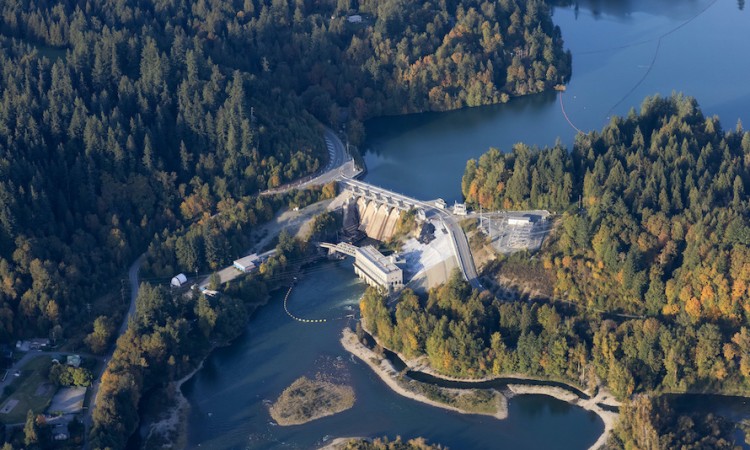
Werner’s blog: What will another year of drought conditions mean for electricity supply in BC?

British Columbians are becoming well-versed in the consequences of dry summers, such as droughts and forest fires, but what about the effect that another dry summer will have on our hydroelectric power supply? UBC Sauder Associate Professor Werner Antweiler discusses in this excerpt from his latest blog post.
It is expected that 2024 will be another drought year in British Columbia. The Canadian Drought Monitor at Agriculture and Agri-Food Canada shows that some areas in B.C. are again suffering from extreme and exceptional drought. At the end of April, 89 per cent of the Pacific Region was classified as "abnormally dry." Rivers are seen receding. And B.C.'s May 2024 Snow Survey and Water Supply Bulletin reported that the provincial snowpack is averaging only 66 per cent of the normal level. What will continued drought conditions mean for electricity supply in British Columbia, which depends on rain fall and snow fall to replenish reservoirs and power our hydro-electric turbines? The month of May is a good time to look at this question as this month marks the onset of the snowmelt season.
As the CBC reported in March, drought conditions in the West Kootenay reduced water levels in Arrow Lake reservoir to the point that the Arrow Lake Generating Station [185-Megawatt capacity] had to shut down. Fortunately, Arrow Lake is one of the smaller power plants in B.C.
Climate change poses notable risks to B.C.'s water resources. A 2013 report from BC Hydro investigated Potential impacts of climate change on BC Hydro's Water Resources. Weather conditions have put B.C. into drought conditions for the third year in a row, and BC Hydro is taking prudent steps to prepare.
BC Hydro's largest dams are along the Columbia River and Peace River. One major reservoir is Kinbasket Lake, created by the Mica Dam, with a capacity of nearly 25 cubic kilometers. The Mica Generating Station has a capacity of 2,816-Megawatts (MW). Below the Mica Dam sits the Revelstoke Reservoir (with just 1.5 cubic kilometers capacity) and the Revelstoke Generating Station with 2,840 MW capacity.
Water levels reach a minimum typically in late April before the lake receives more runoff from the mountains. It is apparent that BC Hydro has been reducing output from the Mica Dam in order to preserve water levels for later in the year, especially during the time when electricity demand peaks during the heating season.
In order to preserve water in this and other reservoirs, BC Hydro needs to import electricity so that output from Mica (and other dams) can be reduced. This makes good business sense. Buying electricity when it is relatively cheap (in the spring) allows BC Hydro (and its trading subsidiary Powerex) to keep the energy stored in the dams and use them in the winter when needed—and even export electricity when it is very profitable in the winter. Reservoirs essentially work like giant seasonal batteries.
The other major reservoir in British Columbia is Williston Lake with a water volume of 74 cubic kilometers, which is created by the W.A.C. Bennett Dam and which powers the Gordon M. Shrum Generating Station with 2,907 MW capacity. Downriver is the Peace Canyon Dam [694 MW] and the new Site C dam [1,100 MW], whose own reservoir will start filling up later this year.
An important part of the water management strategy is the new 83-kilometre-long reservoir behind Site C dam along the Peace River, which will be filled with water from Williston reservoir. The surface area of the Site C reservoir is only about five per cent of the area covered by the Williston reservoir, and water levels in the reservoir will fluctuate only within a narrow range. Holding back sufficient water in Lake Williston now will also ease the filling-up of the Site C reservoir later in the season. The Site C generating station (yet to be named) is expected to start up in early 2025.
Even though BC Hydro's electricity trading has limited the financial impact of B.C.'s current drought conditions, the large amount of net imports do come at a cost even with the benefits from seasonal price arbitrage. Hydro dams are mostly fixed costs; their operating costs are a tiny fraction of their construction cost. Imported electricity is paid for by the Megawatt-hour. The current trading strategy is meant to protect against costly scenarios in the winter when we do not want to depend on imported electricity, and ideally profit from exporting electricity. Yet, the trading does not mean we get a free lunch. BC Hydro will have reduced income from electricity trade, and possibly even net expenses. I fully expect that there will be no room for another B.C. electricity affordability credit in the near future.
Climate scenarios seem to point to long-term precipitation increases for B.C., although combined with a lesser snow pack. This can still pose a challenge because snow pack is "secondary storage" that replenishes reservoirs through run-off later in the season. Even if overall precipitation increases, it won't help unless the water can be captured and stored. If precipitation is too concentrated, it will also mean less capture as run-off can be too quick, as dams may have to open spillways to release excess floodwater.
Join our monthly newsletter and stay up-to-date on our innovative academic programs, world-leading faculty and research, and student and alumni achievements.